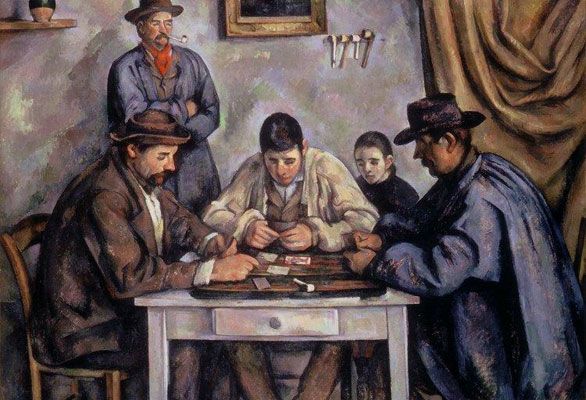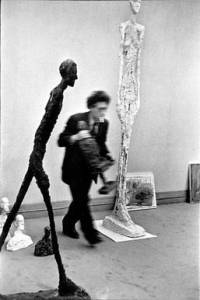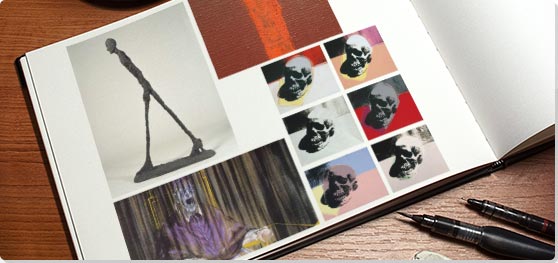Summary of Existentialism in Modern Art
The philosophy of Existentialism was an influential undercurrent in art that aimed to explore the role of sensory perception, particularly vision, in the thought processes. Existentialism stressed the special character of personal, subjective experience and it insisted on the freedom and autonomy of the individual. Jean-Paul Sartre was Existentialism's most prominent advocate in the post-war period, and the bohemian circles in which he moved while in Paris included many artists. In this way, figures such as Alberto Giacometti, Jean Dubuffet, Jean Fautrier and Wols became associated with Existentialist philosophy. It also had some impact in the United States, particularly through the writing of art critic Harold Rosenberg. The philosophy was often poorly understood, even by those who called themselves Existentialists. Nevertheless, it shaped discussion of themes such as trauma, anxiety, and alienation; ideas which were pervasive in post-war art.
Key Ideas & Accomplishments
- Existentialism first emerged in the late-19th century, in the writing of the Danish philosopher Soren Kierkegaard who reacted against the systematic and rational character of Hegel's philosophy and instead insisted on the distinctiveness of personal experience. In the decades that followed, Existentialism grew into a philosophy that placed stress on individual ethics and on the authentic experience of selfhood, on freedom and choice.
- Existentialism's focus on individual experience made it a perfect tool with which to interpret much post-war abstract art. It proved particularly useful to discuss Art Informel, the highly expressive and individualistic abstract art that flourished in Europe after the late 1940s. Some of this work, by painters such as Dubuffet and Wols, addressed the uneasy co-existence of mind and body on which human beings rely, and Existentialism's interest in sensory perception offered a means to negotiate the sometimes difficult divide.
- Existentialism never enjoyed the same popularity among American artists that it did among Europeans. But it did enter the discussions of Abstract Expressionists, particularly through Harold Rosenberg's notion of "Action Painting," which understood the painter's creative process as an act of necessary self-assertion, an expression of freedom and authenticity.
- Existentialism also contributed to discussions of figurative art in the post-war period, shaping responses to the work of Alberto Giacometti and Francis Bacon in particular. This is symptomatic of the popularization of the philosophy, which came to be widely understood as the intellectual expression of anxiety about the fate of humanity in the atomic age.
The Important Artists and Works of Existentialism in Modern Art

The Card Players
Philosopher Maurice Merleau-Ponty argued in "Cézanne's Doubt," an important and influential essay, that Cézanne's painting demonstrated art's interest in subjective perceptions and experiences – indeed the first level of those experiences, before the mind had time to process and reflect upon them. In this sense, Merleau-Ponty suggested, art is opposed to science, which is more interested in analyzing and rationalizing those experiences. Cézanne painted five versions of The Card Players, all towards the end of his life, and each of the pictures might serve as an opening on to themes of Existentialism and Phenomenology, not least because each of Cézanne's players is wholly self-involved, absorbed in his own game.
Oil on canvas - The Metropolitan Museum of Art, New York
The Blue Phantom
The wild and aggressive painting of the Paris-based German artist Wols is characteristic of the European abstract movement Art Informel. Indeed, when Wols arrived at the radically abstract style of his post-war work, many critics recognized it as new and significant. The critic Michel Tapie, who coined the term Informel, said Wols was "the catalyst of a lyrical, explosive, anti-geometrical and unformal non-figuration." The painter Georges Matthieu remarked that "After Wols, everything has to be done anew." And Jean-Paul Sartre claimed Wols for Existentialism, writing that his work was a visualization of our "universal horror of being-in-the-world," our fascination with the "otherness" of worldly phenomena. The Blue Phantom is a key example of the artist's emotional relationship and response to the canvas, and it exemplifies Existentialism's stress on subjective experience. Wols' life might also be taken as an emblem of the ethic of individual freedom that was also championed by Existentialists, since he led a wild life, fast and loose, with little regard for playing by the rules.
Oil on canvas - Private Collection
Study After Velazquez's Portrait of Pope Innocent X
Many art historians and theorists consider Francis Bacon the quintessential Existentialist artist, and his 1953 Study suggests why. It is based on Diego Velázquez's 1650 portrait of Pope Innocent X, but the removal of the head, the addition of the cage-like bars, and the ways Bacon's figure sits behind a kind of screen of vertical brushstrokes all evoke the mood and themes of the post-war philosophy. The figure also seems on the verge of disappearance, as if his corporeal self is literally evaporating. Existentialism cautioned that the battle to retain our sense of self was a constant one, heroic and tragic, and it was urgently necessary if we were not to become little different than the objects that surround us.
Oil on canvas - Des Moines Art Center, Iowa
Walking Man I
Giacometti is the post-war artist who appears to have made the most serious attempt to come to terms with the ideas of Existentialism. He was particularly preoccupied with problems of perception, and how the phenomenon of spatial distance might be registered. These problems go to the heart of Existentialism since they not only touch on our faculties of perception and thought, but also speak to how we relate to one another as isolated human beings separated by physical space. But Giacometti's art also captured the melancholic tone of Existentialism: Walking Man I shows a fragile subject, isolated and exposed to the elements, which consequently have begun to ravage his very being. The man is also emaciated, suggesting that he is slowly withering away, yet he still moves forward, presumably in search of something. As movement is the focal point of Walking Man, the artist adds for his subject the obstacle of loaded feet, almost fused to the ground he treads. Giacometti's Walking Man I is a portrait of man in the throes of an existential crisis.
Bronze - Private Collection
Origins and Ideas
Although the term "Existentialism" was coined by the French philosopher Gabriel Marcel in the 20th century, its roots reach far back; one can even find traces of it in the thought of the Prussian philosopher Immanuel Kant (1724-1804), who argued that mankind was defined by universal qualities. Mankind's essence, in other words, is everywhere the same, and essence precedes his existence in the world, which is contingent on external factors such as history and environment. This theme later played an important role in Existentialism. The philosopher who is often referred to as the "father of Existentialism" is Soren Kierkegaard (1813-1855), who, like Kant, maintained the importance of the individual, and his or her duty to determine the meaning of life.
Beginnings and Development

Jean-Paul Sartre is the philosopher most popularly associated with Existentialism, and he was crucial in disseminating the tenets of the philosophy in post-war Paris. Sartre's activity as a playwright, novelist and literary critic gave his ideas extraordinary reach; his novel Nausea (1938) was particularly important in this regard. Sartre even occasionally wrote essays about artists' work, such as Giacometti, which aided in translating philosophy into the terms of visual art. Sartre described his own approach to the philosophy as Atheistic Existentialism, stating, "If man, as the existentialist conceives him, is indefinable, it is because at first he is nothing. Only afterward will he be something, and he himself will have made what he will be." Sartre argued that mankind is by nature autonomous and alone and is not bound to any ethereal being, or God, but only by the laws he defines for himself.
Phenomenology and Art
Existentialism was closely related to the philosophy of Phenomenology, a theory of knowledge that had a keen interest in the problems of perception. Sartre was important in bringing the two into association, as he was heavily influenced by the ideas of Edmund Husserl, the founder of Phenomenology. But the writer who had the most to bring to bear on Phenomenology in the visual arts was Maurice Merleau-Ponty (1907-61). His 1945 essay, "Cézanne's Doubt," examined Paul Cézanne's investigations into the phenomena of visual perception. Merleau-Ponty argued that through his paintings, Cézanne discovered that "the lived perspective, that which we actually perceive, is not a geometric or photographic one." In other words, art is not an exact science but a means of capturing the complexities of what the eye observes. Merleau-Ponty's ideas, and in particular his book The Phenomenology of Perception (1945), later exerted an important influence on Minimalism.
Figuration and New Images of Man
Existentialism provided abstract painters with a terminology that enabled them to assert the importance of their very personal expressions. But it also served the needs of figurative painters. Some, such as Giacometti, were influenced by Existentialist ideas about the perception of objects in space; as the philosophy touched on how human beings interact, this provided a template for thinking about how the painter might relate to the portrait sitter, something that preoccupied Giacometti a great deal in the post-war years. Existentialism also addressed concerns about the fate and dignity of humanity, which were pervasive in culture in this period. Albert Camus, in his 1953 book The Rebel, wrote of modern man, "In upholding beauty, we prepare the way for the day of regeneration when civilization will give first place... to this living virtue on which is founded the common dignity of man." The "common dignity" to which Camus refers became a focal concern for many artists, who were concerned with how this dignity might be maintained in the face of despair, neurosis, even psychosis.
Existentialism was also a significant influence on the most noted exhibition of figurative art in the 1950s, "New Images of Man," which was staged at the Museum of Modern Art in New York in 1959. The exhibition examined how artists from many nations - Giacometti, Francis Bacon and Willem de Kooning, for example - all gave expression to mankind's dilemmas. In the exhibition catalog, curator Paul Tillich wrote, "in abstract or non-objective painting and sculpture, the figure disappears completely ... [because man] is losing his humanity and becoming a thing amongst the things he produces." MoMA's "New Images" show was, in essence, a protest against this trend.
Action Painting
Art critic Harold Rosenberg's understanding of Abstract Expressionist painting was powerfully shaped by Existentialism. The philosophy played an important role in framing Rosenberg's notion of "Action Painting." When a painter like Willem de Kooning approached the canvas, Rosenberg viewed this as a personal encounter, wherein the process of painting itself revealed the personality of the artist, and all the drama and emotion that comes with it. Action Painting was, for Rosenberg, an existential exercise, a brutally honest form of self-expression.
Useful Resources on Existentialism in Modern Art
- Basic Writings of Existentialism
- Existentialism And Human Emotions
- Existentialism from Dostoevsky to SartreOur Pick
 Ask The Art Story AI
Ask The Art Story AI













